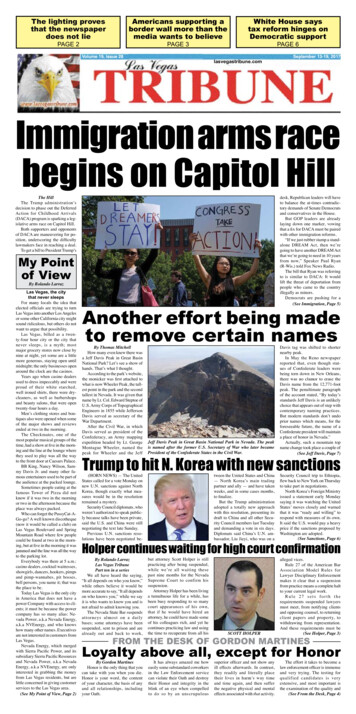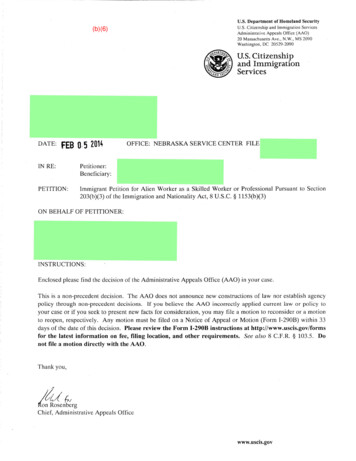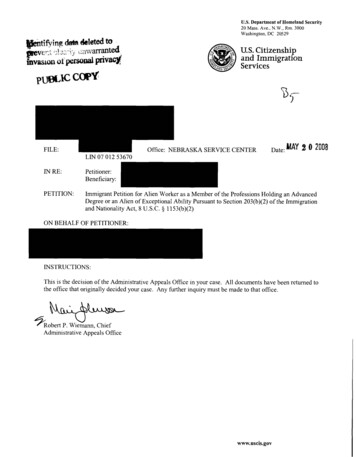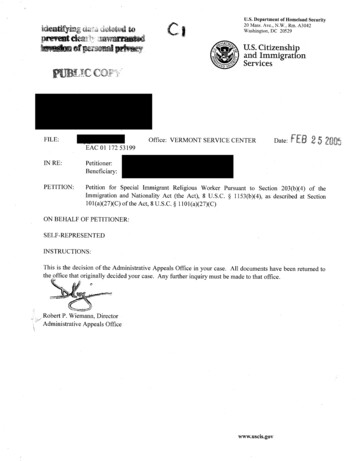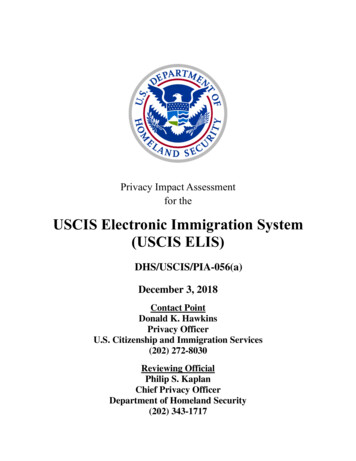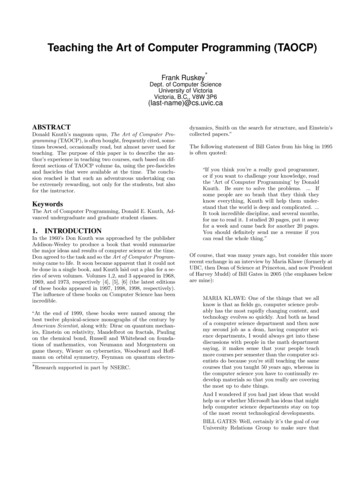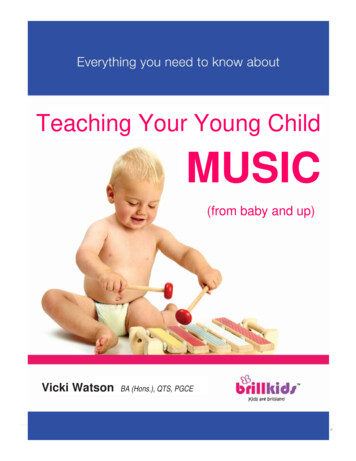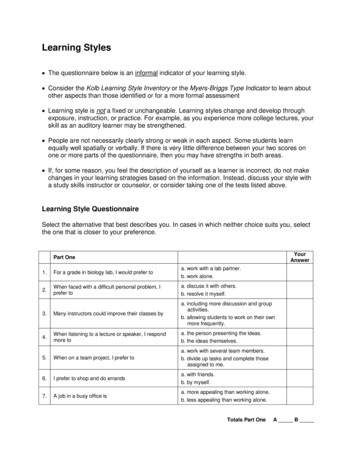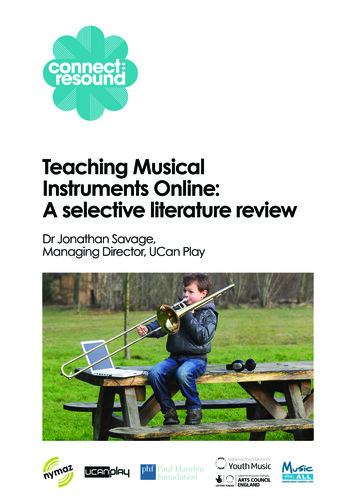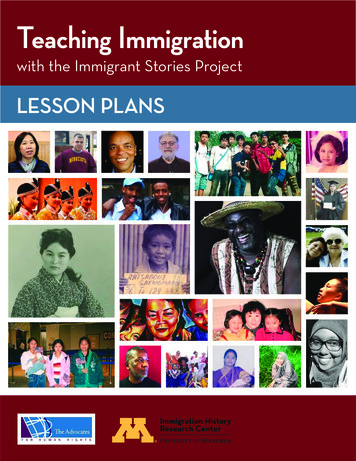
Transcription
Teaching Immigrationwith the Immigrant Stories ProjectLESSON PLANS1
AcknowledgmentsThe Immigration History Research Center and The Advocates for Human Rights would like tothank the many people who contributed to these lesson plans.Lead Editor: Madeline LohmanContributors: Elizabeth Venditto, Erika Lee, and Saengmany RatsaboutDesign: Emily Farell and Brittany LynkVolunteers and Interns: Biftu Bussa, Halimat Alawode, Hannah Mangen, Josefina Abdullah,Kristi Herman Hill, and Meredith Rambo.Archival Assistance and Photo Permissions: Daniel NecasA special thank you to the Immigration History Research Center Archives for permitting thereproduction of several archival photos.The lessons would not have been possible without the generous support of a Joan AldousDiversity Grant from the University of Minnesota’s College of Liberal Arts.Immigrant Stories is a project of the Immigration History Research Center at the University ofMinnesota. This work has been made possible through generous funding from the Digital PublicLibrary of America Digital Hubs Pilot Project, the John S. and James L. Knight Foundation, andthe National Endowment for the Humanities.About the Immigration History Research CenterFounded in 1965, the University of Minnesota's Immigration History Research Center (IHRC)aims to transform how we understand immigration in the past and present. Along with itspartner, the IHRC Archives, it is North America's oldest and largest interdisciplinary researchcenter and archives devoted to preserving and understanding immigrant and refugee life. TheIHRC promotes interdisciplinary research on migration, race, and ethnicity in the United Statesand the world. It connects U.S. immigration history research to contemporary immigrant andrefugee communities through its Immigrant Stories project. It advances public dialogue aboutimmigration through its public programming, supports teaching and learning at all levels, anddevelops archives documenting immigrant and refugee experiences for future generations.About The Advocates for Human RightsAn independent and nonpartisan nonprofit 501(c)(3) organization founded in 1983, TheAdvocates for Human Rights implements international human rights standards to promotecivil society and reinforce the rule of law. Envisioning a world in which every person lives withdignity, freedom, justice, equality, and peace, The Advocates investigates and exposes humanrights violations; represents people seeking asylum; trains and assists human rights defenders;and uses research, education, and advocacy to engage the public, policymakers, and children inhuman rights work. Holding Special Consultative Status with the United Nations, The Advocatescollaborates with human rights defenders throughout the world to bring information abouthuman rights violations and make recommendations to international human rights mechanisms. 2017 The Advocates for Human Rights. All rights reserved. Reproduction for educational use permitted.Photo on page 15: UN PhotoArchival photos: Immigration History Research Center Archives.Immigrant Stories Photos: Immigration History Research Center, CC BY-NC 4.0All maps: Wikimedia Commons1
TABLE OF CONTENTSIntroduction 3About the CurriculumAbout Energy of a NationAbout the Immigrant Stories ProjectSocial Studies StandardsAdvisory on Immigration StatusUnit 1: Understanding Immigration9Lesson 1: Why Immigrate?Lesson 2: The U.S. Immigration SystemLesson 3: Experiences in the U.S.122032Optional LessonsOptional Lesson 1: Deciding to Immigrate: A HistoryOptional Lesson 2: Waves of ImmigrationOptional Lesson 3: Waiting in Line GameOptional Lesson 4: Spot the MythsOptional Lesson 5: A History of Xenophobia333444505761Unit 2: Refugees and Asylum Seekers89Lesson 1: Refugee BasicsLesson 2: The Global Refugee PictureLesson 3: The Refugee Journey9296112Optional LessonsOptional Lesson 1: Refugee Role PlayOptional Lesson 2: Applying for Asylum-hay114115121Unit 3: Youth, Identity, and ImmigrationLesson 1: Culture and IdentityLesson 2: Second-Generation IdentityLesson 3: Constructing Identity234567125128135137
INTRODUCTIONAbout the Lesson PlansTeaching Immigration with the Immigrant Stories Project contains lessons for grades 8 to adultaudiences that help students learn about aspects of United States immigration, past and present,through the personal experiences of immigrants and refugees. The lessons highlight digital storiesfrom the Immigrant Stories collection: brief, original videos made by immigrants and refugees. Thiscurriculum is a partnership between the Immigration History Research Center at the University ofMinnesota and The Advocates for Human Rights.Teaching Immigration with the Immigrant Stories Project includes three units:»» “Unit One: Understanding Immigration” introduces students to why and how individuals andfamilies immigrate. Students will study global push and pull factors and examine individualimmigrants’ stories to understand how people make decisions in response to these conditions.»» “Unit Two: Refugees and Asylum Seekers” introduces students to the U.S. refugee and asylumsystems. Students will understand these systems through a human rights perspective bycomparing the experiences of individual refugees and asylum seekers who have come to the U.S.since World War II.»» “Unit Three: Youth, Identity, and Immigration“ teaches students about the experiences ofimmigrant youth and immigrants’ children. These include explorations of identity, belonging,discrimination, self-expression, and heritage.Each unit is centered around several digital stories from the Immigrant Stories collection. They arecreative and poignant reflections on personal and family immigration experiences. These videosinclude accounts of families separated and reunited, memories of life in refugee camps, and findinglove and pursuing education thousands of miles from home. The videos are generally 3-5 minuteslong, so students may watch several in class. Classroom activities also encourage students to considerimmigration systems and experiences from individuals’ perspectives.Each unit also incorporates human rights as a framework for understanding immigration.Approaching immigration through the lens of human rights helps to build empathy; encouragecritical thinking; examine root causes and long-term solutions; and draw connections betweenfacts, immigrant experiences, and the foundational principles of the Universal Declaration of HumanRights: dignity, justice, equality, freedom, and peace for all people.Teachers may choose to teach one unit or all three, and Units One and Two have additional optionalactivities. This curriculum includes lesson plans, classroom activities, worksheets, backgroundsummaries, and up-to-date fact sheets for teaching about many aspects of contemporaryimmigration. PowerPoints explaining complex aspects of the U.S. immigration system are availableto download. The curriculum is applicable in a variety of subjects, including social studies, history,geography, English, media studies, and literature.3
INTRODUCTIONAbout Energy of a NationThe lesson plans in Teaching Immigration with the Immigrant Stories Project are based on Energy ofa Nation: Immigrants in America, 3rd Edition, published by The Advocates for Human Rights in 2012.The lessons have been fully updated and revised, with engaging new content drawn from the richresources of the Immigrant Stories project.OF AENERGYNATIONImmigrants in AmericaThird EditionThe Energy of a Nation curriculum was first created to provide teacherswith thoughtful, factual lessons on the complex, and often sensitive, topicof immigration. Originally written in 1997, with a second edition in 2004,online updates in 2006, and the 3rd edition in 2012, the curriculum has beenused in diverse communities across the country. Teachers who have usedthe curriculum say it is “precise and researched thoroughly,” praising its “upto-date data.” Teachers reported that lessons were engaging and did theimportant task of helping students dispel popular myths about immigrants.In addition to recognition from educators, Energy of a Nation was also included in Human RightsEducation in the School Systems of Europe, Central Asia and North America: A Compendium of GoodPractice, compiled by the OSCE/Office for Democratic Institutions and Human Rights, the Office of theUnited Nations High Commissioner for Human Rights, the Council of Europe, and the United NationsEducational, Scientific, and Cultural Office.Available online, the full curriculum offers additional lessons and resources for educators, including:yy The root causes of undocumented immigration;yy The complex realities of removal through the immigration courts;yy Other countries’ experience with, and response to, immigration;yy Xenophobia and public discourse around immigration;yy Local and national U.S. policy considerations; andyy Service-learning opportunities to create a welcoming school and community.The curriculum is filled with engaging, student-centered activities that follow best practices forhuman rights education (HRE). Information is presented through easy-to-read charts, tables, graphs,maps, images, Venn diagrams, and scripts. Students learn by writing from the perspective of animmigrant; exploring their own migration history; deciding under what conditions they mightrisk undocumented status; holding mock immigration court; drawing a picture to represent animmigration policy; rehearsing a deliberative dialogue about immigration; constructing a gallery ofxenophobia over the centuries; and creating a service-learning project for their classroom or school.Download the curriculum at: anation.4
INTRODUCTIONAbout the Immigrant Stories ProjectImmigrant Stories is a digital storytelling andarchiving project run by the University of Minnesota’sImmigration History Research Center (IHRC). Foundedin 1965, the IHRC and its partner, the IHRC Archives,are North America’s oldest and largest interdisciplinaryresearch center and archive of immigrant and refugeelife. Since 2013 Immigrant Stories has collected, shared,and preserved the experiences of contemporaryimmigrants and refugees.A digital story is an original 3-5 minute video that tellsa personal story. Participants write their own story,record an audio voiceover, and add images and sound(including personal photos, family documents, home videos, and original music) to create a briefvideo. To view the entire Immigrant Stories collection, visit: http://z.umn.edu/iscollection.The project defines "immigrant" broadly. There is no one way to tell an immigrant story because nosingle story represents all immigrants and their histories. The collection contains stories from firstgeneration immigrants and refugees – that is, people born outside the country where they currentlyreside – as well as stories created by their children and grandchildren. Immigrant Stories have beencreated by international students, transnational adoptees, and people who might not feel that theirexperiences fit a particular (or just one) category.The IHRC believes these personal narratives are important primary sources for teaching and research,both now and for future generations. Therefore, all videos in the Immigrant Stories collection will beprofessionally preserved in the IHRC Archives.Participate in Immigrant StoriesImmigrant Stories provides free tools, resources, and curriculum so your students can make their ownvideos and participate in the project.The Website: Students can create their digital stories entirely within the Immigrant Stories website,http://immigrantstories.umn.edu. Students only need access to a computer and the Internet to tell apersonal or family immigration story. Students create their story in a series of steps, including writinga story, recording their voiceover, and editing a video. The website provides writing prompts, tutorialvideos, access to video editing tools, and an optional, click-through donation form. The website isavailable in several languages, including Spanish, Chinese, and Arabic.The IHRC encourages – but never requires – students to add their stories to the Immigrant Storiescollection, but they must be at least 18 years old, or 15-17 with a parent or guardian’s permission.Curriculum: Immigrant Stories provides additional curricula so students can make a digital story asan in-class project. Students use the website and turn in a series of assignments, culminating in theirfinal video. Each packet contains lesson plans, a schedule of assignments, a grading rubric, studentworksheets, and simple technical instructions. Download the curricula for high schools, colleges, ELLprograms, and workshops here: http://z.umn.edu/iscurriculum.5
INTRODUCTIONSocial Studies StandardsThese lessons connect with key social studies content standards for middle and high school. The listbelow shows how the lessons and activities relate to different concepts frequently found in socialstudies standards for middle and high school.General themeU.S. immigration - historicalSample standardTrace the role of migration and immigration of people in the development ofthe United States.Unit 2 Lesson 2, The Global Refugee Picture, page 96Unit 3 Lesson 2, Second-Generation Identity, page 135Unit 1 Optional Lesson 1, Deciding to Immigrate: A History, page 34Unit 1 Optional Lesson 2, Waves of Immigration, page 44Unit 1 Optional Lesson 5, A History of Xenophobia, page 61Relevant lessonsGeneral themeU.S. immigration - contemporarySample standardRelevant lessonsDescribe the process by which immigrants become U.S. citizens.Unit 1 Lesson 1, Why Immigrate?, page 12Unit 1 Lesson 2, The U.S. Immigration System, page 20Unit 1 Lesson 3, Experiences in the U.S., page 32Unit 2 Lesson 1, Refugee Basics, page 92Unit 2 Lesson 3, The Refugee Journey, page 112Unit 1 Optional Lesson 3, Waiting in Line Game, page 50Unit 1 Optional Lesson 4, Spot the Myths, page 57Unit 2 Optional Lesson 2, Applying for Asylum-hay, page 121General themeMapping the movement of peopleSample standardRelevant lessonsAnalyze the spatial organizations of people, places and environment inrelation to changes in society.Unit 2 Lesson 2, The Global Refugee Picture, page 96General themeConflict and human migrationSample standardRelevant lessonsHow has conflict over space and resources influenced human migration?Unit 1 Lesson 1, Why Immigrate?, page 12Unit 2 Lesson 1, Refugee Basics, page 92Unit 2 Lesson 2, The Global Refugee Picture, page 96Unit 2 Lesson 3, The Refugee Journey, page 112Unit 2 Optional Lesson 1, Refugee Role Play, page 115General themeCulture and cultural diffusionSample standardAnalyze how cultural diffusion is influenced by factors such as trade,migration, immigration and conflict.Unit 3 Lesson 1, Culture and Identity, page 128Unit 3 Lesson 2, Second-Generation Identity, page 135Unit 3 Lesson 3, Constructing Identity, page 137Relevant lessons6
INTRODUCTIONAdvisory on Immigration StatusStudents in any classroom may be affected by immigration issues, either because they themselvesare immigrants or because they have immigrant family members. Teachers should always follow afew basic guidelines to ensure they do not inadvertently leave these students feeling singled out,uncomfortable in discussions or activities, or exposed to potential negative consequences in theimmigration system.1. Maintain Confidentiality: In classroom discussions or in private conversations, studentsmay disclose information about their immigration status. This information should be keptconfidential unless there are overriding concerns about the student’s safety or health. Evenseemingly harmless information may result in negative outcomes in immigration proceedings,including detention and deportation.2. Encourage Participation Without Singling Out: Immigrant students have unique insightinto the immigration process and its effect on families, communities, and their own lives.Indeed, one of the benefits of teaching about immigration is providing immigrant studentswith an opportunity to demonstrate their expertise and knowledge. However, do not assumethey want to participate. Avoid singling them out, as they may feel “on display” in front oftheir classmates. Students should never feel as if they need to speak for, or represent, allimmigrants.3. Be Inclusive. Introducing this topic by talking about “migration” (as opposed to“immigration”) allows teachers to be inclusive of all students. This includes Native Americanswhose ancestors have a history of migration, both voluntary and forced, within the UnitedStates, as well as African Americans who suffered forced migration during the slave trade. Beaware of the diversity of American migration histories when discussing the topic.4. Discourage Sharing Status: Remind students that they do not need to share any informationabout their own immigration stories, especially when it involves their immigration status.Children are sometimes unaware of the consequences of talking about their status, or theymay feel the classroom is a private, safe space. Remind them that things said in the classroomare public and that they may want to keep the details of their immigration status private.5. Require Respectful Conversation: Many of the lessons involve group or classroomdiscussions about potentially controversial immigration issues. Students may have a widevariety of opinions and strength of feeling. Remind students that their classmates may beimmigrants or have immigrant family members, and that they need to be respectful and avoidattacks, heated language, or bigoted jokes directed against immigrants.6. Avoid Re-traumatization: Some of the lessons in the curriculum explore emotional andsensitive subjects. Students who have experiences related to those subjects, such as therefugee journey, may find it difficult to participate. Discuss lessons with students in advance,hold private conversations with students you think may be personally affected, offeralternative activities, and stop any lesson that becomes upsetting.7.Provide Appropriate Support: Students may view their teachers as one of the few authorityfigures that are safe to talk to about their immigration issues. Know your limits in providingassistance. Many immigration questions can only be answered by lawyers. Keep a referrallist of reputable low-cost or free immigration legal service providers who can help answerstudents’ questions. The Immigration Advocates Network provides a national directory oflegal service providers at ldirectory/.7
8
UNIT 1Understanding ImmigrationRefugees arriving at Minneapolis-St. Paul International Airport.From Paw Hser Nor Htoo’s Immigrant Story.9
UNIT 1UnderstandingImmigrationGoal»» Understand why and how people immigrate to the United States and how the immigrationsystem can affect human rights.Objectives»» Students will understand key immigration vocabulary.»» Students will be able to define human rights in their own words.»» Students will be able to describe the reasons why people would want to leave their homecountries.»» Students will connect reasons for immigrating to the human rights described in the UniversalDeclaration of Human Rights.»» Students will understand the basic categories of immigrants admitted to the United States.»» Students will evaluate the current U.S. immigration system from a human rights perspective.At a GlanceLesson 1: Why Immigrate?»» In this three-part lesson, students learn basic definitions of migration, immigration, andemigration. They are introduced to human rights through the Universal Declaration of HumanRights and connect immigration to human rights issues. Finally, they watch an Immigrant Storyvideo and analyze why that person or their family chose to immigrate.Lesson 2: The U.S. Immigration System»» Students study facts about the U.S. immigration system and how it operates. They revisit theirchosen Immigrant Story from Lesson 1 and examine how the U.S. immigration system affectedthe person in their story.Lesson 3: Experiences in the U.S.»» Students listen to the person in their chosen Immigrant Story describe their experiences oncethey arrived in the United States and, as a class, students compare all the stories.10
Featured Immigrant StoriesMay Losloso: May was born in the Philippines in 1982. Her father served in the U.S. armyand often visited the Philippines, but May and her mother did not receive permission to livewith him in the United States until /immigrantstories-exhibit/item/651Mary Fray: Mary was born Anna Maria DiMillo in Italy in 1925. She and her family immigratedto the United States when she was six to escape the government of Benito Mussolini, andshe grew up in Maine. She married William Fray, the son of Swedish immigrants, in the w/immigrantstories-exhibit/item/564Nancy Fong: Nancy and her family moved from Hong Kong to the United States in 1962 toreunite with her father, who had come to the United States in 1960 in search of work. Nancygrew up in how/immigrantstories-exhibit/item/562Saengmany Rastabout: Saengmany and his family became refugees after the civil warin Laos. They spent two and a half years in refugee camps in Thailand before finally beingresettled in the United States in 1986, when he was four years immigrantstories-exhibit/item/508Thiago Heilman: Thiago was born in Brazil in 1984. In April 1996, his family came to NewYork and he stayed in the U.S. to continue his education after his family returned to Brazil.Thiago obtained his first U.S. legal documents and enrolled in college in 2012, when theObama administration created the Deferred Action for Childhood Arrivals (DACA) how/immigrantstories-exhibit/item/573William Nyang’un: William, the youngest of five children, was born in Kenya in 1990. Hismother moved to the United States when he was six months old, leaving him in his family’scare. His siblings later moved to the United States too, and William joined them in /immigrantstories-exhibit/item/57511
LESSON 1 Why Immigrate?Part 1: Defining Immigration1. Prepare. Write each of the following questions about migration (without the answers) on aseparate sheet of paper and hang them around the room.yy When do you think that humans first began to migrate?Although this is still debated among historians and archaeologists, humans are thought to havefirst migrated from Africa between 60,000-80,000 years ago.1 From the earliest times, migrationhas been part of the human experience.yy Do you think that a greater percentage of the world’s population is migrating today than inprevious periods? Why or why not?The total number of immigrants worldwide has been increasing steadily in the last 50 years,reaching 244 million in 2015. However, since the total world population is also increasing, thepercentage of people who are migrants remains around 3%.2yy List three reasons why people migrate. Do you think that the reasons for migration havechanged over the years?Many of the reasons that people migrate are the same today as they have been for centuries:a desire to be with family members; a search for food, shelter, and economic opportunity; or aneed to escape war or political repression. Migration can also be involuntary, when one groupuses violence to displace another.yy If you were going to move to another country, what are some issues you would need toconsider?Answers will vary, but might include: learning a new language or culture; obtaining a visa;leaving behind family and friends; finding employment, schools, and/or housing; transportingpets; adapting to different climates/weather; paying for and arranging the move; findingtransportation in a new country; leaving personal possessions behind; or accessing services.Teacher TipIntroducing this topic by talking about “migration” (as opposed to “immigration”) allowsteachers to be inclusive of all students. This includes Native Americans whose ancestors havea history of migration, both voluntary and forced, within the United States, as well as AfricanAmericans who suffered forced migration during the slave trade. Be aware of the diversity ofAmerican migration histories when discussing the topic.(continued on next page)1212Patrick Manning and Tiffany Trimmer, Migration in World History. 2nd edition, London: Routledge, 2013.International Organization for Migration, “Global Migration Trends Factsheet,” 2015, eet.
LESSON 1 Why Immigrate?(continued from previous page)2. Define. Ask students what they think the term “migration” means. Write their answers on theboard. Next, ask them to define “immigration.” What is the difference between migration andimmigration? Provide the following definitions:yy Migration: people moving from one place to anotheryy Emigration: people moving out of a countryyy Immigration: people moving into a new countryExplain to students that migration is a fundamental human experience that has been going on forthousands of years. Immigration, in contrast, is a more recent phenomenon, the result of countriesdeciding to regulate and control the movement of people across national borders. While everyperson in the United States has some family history of migration, everyone does not have a similarexperience with immigration.3. Think. Divide the class into small groups of two or three students and give each group a smallstack of sticky notes. Have each small group go around, read each question, and then discusspossible answers with their small group. Ask students to write their best answer on their sticky notesand put them under the question.4. Discuss. After the small groups have visited all the questions, bring them back together as a largegroup and discuss their answers. Students can volunteer their answers or the teacher can chooseto read some of the sticky notes under each question. Once students have discussed their answers,provide the sample answers above and compare them to the students’ answers.Yan Naung in a Thai airport before resettling in the United States.From Yan Naung’s Immigrant Story.13
LESSON 1 Why Immigrate?Part 2: Human Rights and the Decision to Leave1. Write. Instruct students to copy the phrase “human rights” into their notebooks. Ask studentsto write their own definition of human rights. Next, have students work in pairs to discuss theirdefinitions and use them to create a new, comprehensive definition.2. Define. Write the question “What are human rights?” on the board. Have students share andcompare their answers with the class. Offer the following definition of human rights:“The principles of human rights were drawn up by human beings as a way of ensuring that thedignity of everyone is properly and equally respected, that is, to ensure that a human being willbe able to fully develop and use human qualities such as intelligence, talent and conscience andsatisfy his or her spiritual and other needs.“3The class should collectively decide on a definition to be used throughout this unit. Make sure that itcovers the concepts contained in the UN definition. Post the class’s definition in a visible location.3. Brainstorm. Once the class agrees on a definition of human rights, try to brainstorm as manydifferent rights as possible, writing the answers on the board. Try to get the students to identifyas many of the rights listed in the Universal Declaration of Human Rights (UDHR) as possible (seeHandout 1: The Universal Declaration of Human Rights). Use the following questions to promptstudents if they get stuck:yy What rights do we protect in the United States in our Constitution and Bill of Rights?(possible answers: freedom of speech, religion, and assembly; right to a fair trial; freedom fromarbitrary arrest)yy What is the minimum that people need to live in dignity?(possible answers: food, housing, health care, education)yy Think of famous movements in our country’s history - what kind of rights were they fighting for?(possible answers: freedom from slavery, non-discrimination, right to vote)(continued on next page)314Australian Human Rights Commission, “Understanding Human Rights,” -rights.
LESSON 1 Why Immigrate?(continued from previous page)Give students a copy of Handout 1: The Universal Declaration of Human Rights. Add to the list anyrights from the UDHR that the students did not generate on their own. Explain that all of these rightsare included in the Universal Declaration of Human Rights, which was written by representativesfrom countries all over the world, including the United States. The UDHR defines the basic rights thatall people are entitled to, no matter who they are or what country they live in.4. Connect. Explain to students that many of the reasons that people choose to immigrate areclosely related to the protection of human rights around the world and in the United States. Examinethe list of human rights that the class brainstormed and circle the ones that might lead a person tochoose to leave their home country. Add any other reasons a person might choose to immigrate thataren’t on the original list and see if they can be connected to a right in the UDHR.In 1950, on the second anniversary of the adoption of the Universal Declaration of Human Rights,students at the UN International Nursery School in New York viewed a poster of the historic document.15
LESSON 1 Why Immigrate?Part 3: The Choice in Their Own Words1. Choose a video. Divide the class into small groups of 3-5 students. Provide the groups with a listof the 6 Immigrant Stories on page
available in several languages, including Spanish, Chinese, and Arabic. The IHRC encourages – but never requires – students to add their stories to the Immigrant Stories collection, but they must be at least 18 ye

